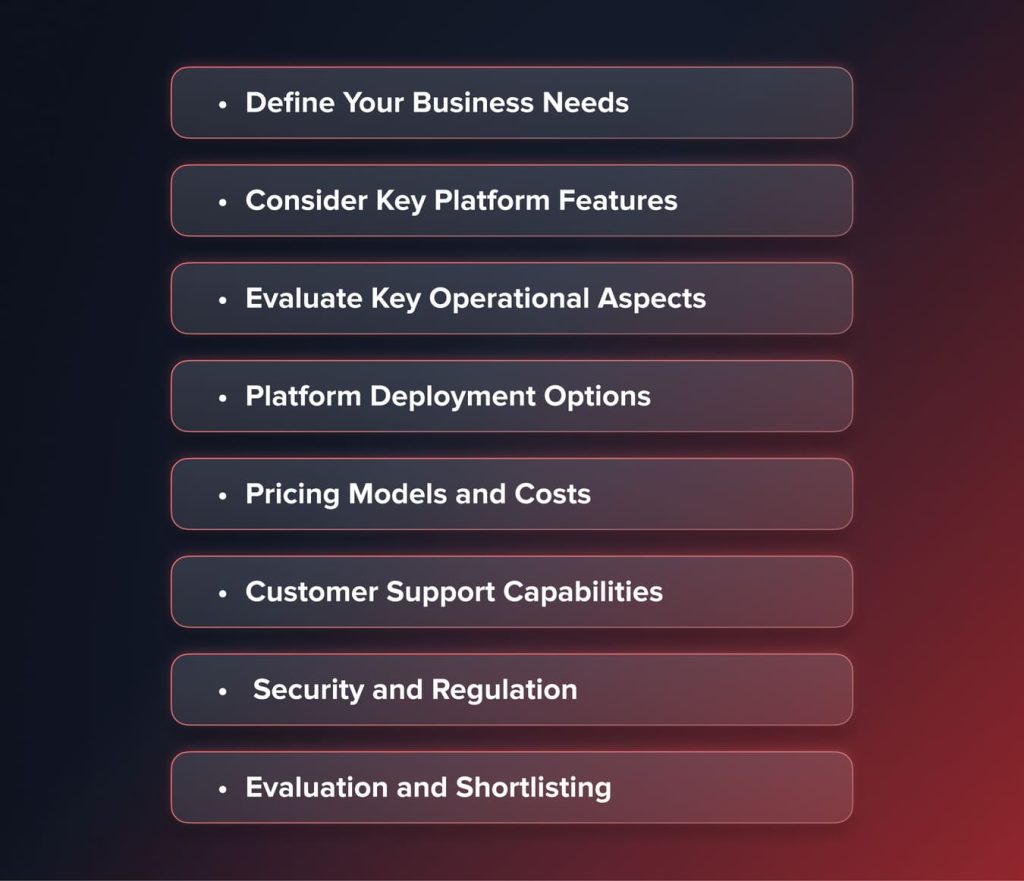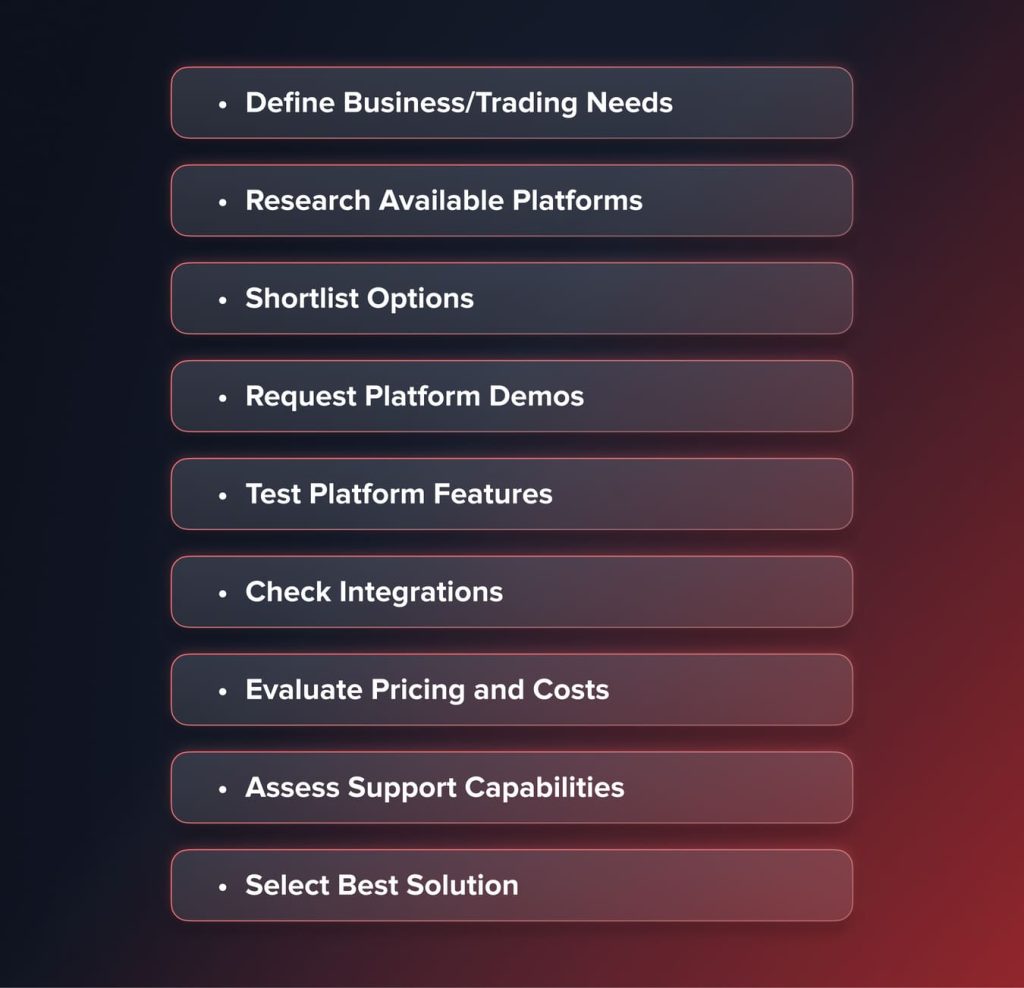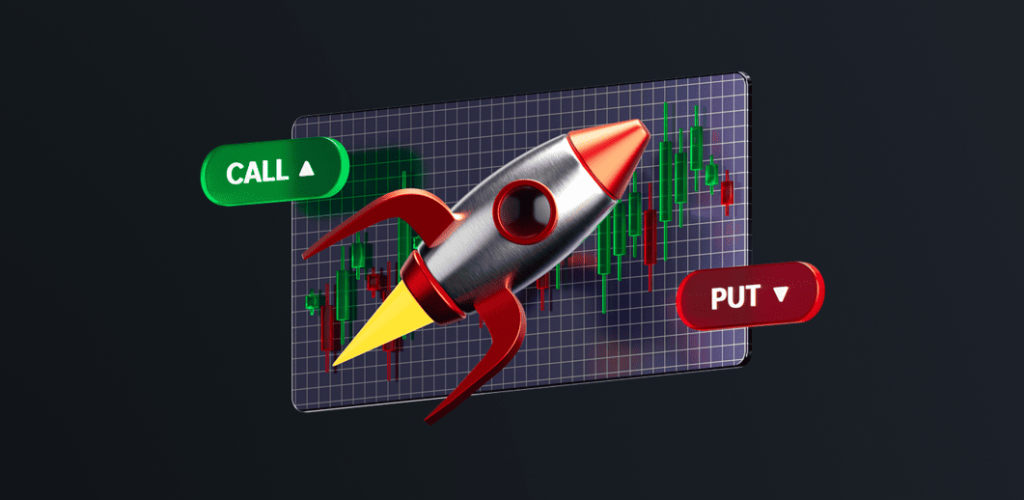
Làm thế nào để chọn một giải pháp nền tảng giao dịch? – Mẹo cho người mới bắt đầu
Mục lục
Nền tảng giao dịch là giải pháp phần mềm quan trọng giúp các công ty môi giới cung cấp dịch vụ trực tuyến cho khách hàng tiếp cận thị trường tài chính toàn cầu và quản lý hoạt động hiệu quả.
Với nhiều sản phẩm có sẵn trên thị trường, việc lựa chọn quá nhiều sản phẩm cũng là một vấn đề nan giải, do đó, việc lựa chọn giải pháp nền tảng giao dịch phù hợp đòi hỏi phải cân nhắc nhiều yếu tố.
Hướng dẫn chi tiết này sẽ hỗ trợ các nhà môi giới đang tìm kiếm giải pháp tối ưu cho quy trình lựa chọn bằng cách nêu rõ các yếu tố chính mà nhà cung cấp cần được xem xét. Trong các phần tiếp theo, bạn sẽ tìm hiểu cách thức hoạt động của các nền tảng giao dịch, xem xét các loại phổ biến, xác định các tiêu chí đánh giá cần thiết và cuối cùng, đề xuất các giải pháp tối ưu hóa cho nhu cầu kinh doanh cá nhân và mang lại trải nghiệm giao dịch vượt trội.
Nền tảng giao dịch là gì?
Nền tảng giao dịch là một hệ thống trực tuyến, được kết nối mạng để thực hiện các giao dịch chứng khoán thông qua các chương trình máy tính tích hợp. Nền tảng này cung cấp cơ sở hạ tầng cho phép các nhà môi giới làm trung gian giữa nhà giao dịch và thị trường tài chính trong việc truyền dữ liệu giá trực tiếp và thực hiện lệnh mua/bán điện tử thay mặt khách hàng. Các hệ thống hàng đầu có kiến trúc cơ sở dữ liệu mạnh mẽ, hỗ trợ tính minh bạch, các tính năng bảo mật nâng cao và cung cấp thanh khoản thứ cấp.
Có một số công cụ giao dịch, chẳng hạn như cổ phiếu, quyền chọn, cặp tiền tệ, hoặc thậm chí là tiền điện tử, mà các nhà giao dịch có thể truy cập theo thời gian thực thông qua giao diện tùy chỉnh. Các tính năng bổ sung bao gồm công cụ nghiên cứu, biểu đồ, đặt lệnh và số liệu hiệu suất lịch sử để đưa ra quyết định. Nhìn chung, các nền tảng giao dịch cung cấp một thị trường điện tử có khả năng tạo điều kiện thuận lợi cho việc tham gia xuyên biên giới với sự hỗ trợ của các đối tác chiến lược.
Các loại nền tảng giao dịch
Nhìn chung có hai loại nền tảng giao dịch chính: độc quyền và thương mại. Nền tảng độc quyền (còn gọi là "prop") được thiết kế và phát triển bởi chính các nhà môi giới, ngân hàng và tổ chức tài chính lớn. Chúng được sử dụng nội bộ cho các mục đích như thử nghiệm chiến lược giao dịch. Mặt khác, các nền tảng thương mại được tạo ra bởi các nhà cung cấp phần mềm độc lập và nhắm đến các nhà giao dịch bán lẻ hoặc nhà đầu tư chuyên nghiệp.
Nền tảng giao dịch cũng có thể được phân loại dựa trên thiết bị hoặc giao diện được sử dụng để truy cập. Nền tảng máy tính để bàn yêu cầu cài đặt trên máy tính, trong khi nền tảng web có thể được sử dụng trực tiếp thông qua trình duyệt web mà không cần tải xuống bất kỳ phần mềm nào. Ngoài ra còn có các ứng dụng di động được tối ưu hóa đặc biệt để giao dịch trên điện thoại và máy tính bảng thông qua giao diện di động.
Loại nền tảng phù hợp với từng nhà giao dịch cụ thể phụ thuộc vào mục tiêu, địa điểm ưa thích và loại hình hoạt động giao dịch được thực hiện. Trong khi phiên bản máy tính để bàn thường cung cấp các tính năng tiên tiến nhất, các giải pháp dựa trên web và ứng dụng hiện đại cố gắng thu hẹp khoảng cách về chức năng để tăng tính linh hoạt.
You may also like

Các yếu tố cần xem xét khi lựa chọn giải pháp nền tảng giao dịch
Việc lựa chọn nền tảng giao dịch phù hợp là điều cần thiết đối với các nhà giao dịch và nhà đầu tư đang tìm kiếm một môi trường giao dịch tối ưu, phù hợp với nhu cầu và mục tiêu cá nhân. Với rất nhiều lựa chọn trên thị trường, mỗi lựa chọn đều có những tính năng và chức năng riêng biệt, việc đưa ra quyết định sáng suốt có thể khá khó khăn. Tuy nhiên, việc chia nhỏ quy trình thành các lĩnh vực chính cần cân nhắc sẽ giúp việc thu hẹp danh sách lựa chọn trở nên dễ dàng hơn. Giờ hãy cùng tìm hiểu từng yếu tố một.

1. Xác định nhu cầu kinh doanh của bạn
Đối với các công ty môi giới, định nghĩa này bắt đầu từ bên trong. Nó bao gồm việc phân định các tài sản có thể giao dịch, hồ sơ khách hàng mục tiêu, các phương thức thanh toán ưu tiên và các loại lệnh giao dịch phù hợp với chiến lược trước khi tiếp cận nhà cung cấp.
Sẽ cung cấp xoay quanh ngoại hối, CFD trên hàng hóa , hoặc thậm chí bao gồm cả tiền điện tử? Đối tượng mục tiêu chủ yếu là những nhà đầu cơ bán thời gian hay toàn thời gian với các yêu cầu tuân thủ khác nhau?
Hiểu rõ các trường hợp sử dụng này sẽ đặt ra kỳ vọng về khả năng của nền tảng. Tài liệu yêu cầu phù hợp đảm bảo hỗ trợ đã được thẩm định cho các tiêu chuẩn quản trị rủi ro, chẳng hạn như điểm thanh lý tự động hoặc bảo hiểm số dư âm; các nhà cung cấp giải pháp có thể đưa ra các khuyến nghị rõ ràng và tùy chỉnh.
2. Xem xét các tính năng chính của nền tảng
Ngoài các tiêu chí nội bộ, các nhà môi giới còn khảo sát các bộ tính năng trên khắp các dịch vụ. Phạm vi bảo hiểm tài sản toàn diện mở rộng khả năng, đồng thời tiếp cận trực tiếp đến sàn giao dịch. tính thanh khoản Nhân rộng tiềm năng mở rộng. Biểu đồ nâng cao được xây dựng sẵn kết hợp với các chỉ báo kinh tế và luồng tin tức để hỗ trợ việc ra quyết định dựa trên phân tích. Giao diện tùy chỉnh cao, phù hợp với nhu cầu hoặc vai trò cá nhân, giúp thúc đẩy sự chuyên môn hóa.
Hơn nữa, việc tích hợp thanh toán liền mạch giúp việc đăng ký và rút tiền trở nên dễ dàng. Bảng xếp hạng Ensemble và chức năng sao chép giao dịch thúc đẩy việc xây dựng cộng đồng, đồng thời các tài liệu giáo dục nuôi dưỡng sự phát triển kỹ năng. Khả năng tương thích trên thiết bị di động cho phép truy cập từ mọi nơi, mọi lúc. Sự kết hợp của các tính năng này rất quan trọng trong việc tối ưu hóa trải nghiệm của nhà giao dịch, vốn là cốt lõi của việc giữ chân và giới thiệu khách hàng.
3. Đánh giá các khía cạnh hoạt động chính
Ngoài các chức năng giao diện, việc xem xét bao gồm hậu cần Hiệu quả quản trị. Quyền người dùng mạnh mẽ và kiểm soát nhóm đảm bảo tuân thủ quy định, đồng thời giám sát khối lượng giao dịch, vị thế mở và doanh thu thông qua bảng điều khiển tùy chỉnh, mang lại khả năng hiển thị theo thời gian thực. Việc thực hiện lệnh trực tiếp liên kết với các sàn giao dịch hoặc ngân hàng bên ngoài giúp đơn giản hóa quá trình xác nhận.
Hỗ trợ nhiều loại tiền pháp định và tiền điện tử đáp ứng nhu cầu thanh khoản toàn cầu. Việc trích xuất báo cáo hiệu suất và rủi ro hỗ trợ việc tuân thủ, trong khi việc mở tài khoản kỹ thuật số đa ngôn ngữ và cổng thông tin dịch vụ khách hàng tích hợp giúp nâng cao chất lượng dịch vụ khách hàng. Việc đặt máy chủ trong phạm vi khu vực pháp lý cũng giúp đơn giản hóa việc tuân thủ các tiêu chuẩn địa phương.
4. Tùy chọn triển khai nền tảng
Lựa chọn giữa quản lý cơ sở hạ tầng tại chỗ và triển khai đám mây phải dựa trên giá trị mà mỗi giải pháp mang lại. Trong khi các giải pháp lưu trữ riêng tư chuyển giao trách nhiệm nâng cấp/mở rộng, chi phí phần cứng ban đầu và nhu cầu về nhân sự chuyên trách lại rất tốn kém so với ngân sách. Mặt khác, trong khi các nền tảng đám mây chuyển giao gánh nặng vận hành mạng cho các nhà cung cấp đáng tin cậy, thì các thỏa thuận về phí cấp phép dựa trên mức sử dụng liên tục vẫn duy trì tính linh hoạt.
Những cân nhắc khác bao gồm việc sao chép dữ liệu trên các địa điểm phục hồi sau thảm họa khác nhau về mặt địa lý để đảm bảo tính liên tục; việc vá lỗi bảo mật thường xuyên và khả năng hiển thị để tránh mọi hành vi khai thác, cũng như tính khả dụng của dữ liệu trên thiết bị đầu cuối máy tính để bàn hoặc thiết bị di động. Việc thẩm định kỹ lưỡng các kịch bản kinh doanh sẽ xác định cấu hình tốt nhất.
5. Mô hình định giá và chi phí
Để có thể dự đoán ngân sách chính xác, việc làm rõ các mô hình định giá là điều cần thiết. Phí cấp phép trả trước cho các dịch vụ triển khai ban đầu sẽ được tính vào chi phí phần mềm dưới dạng dịch vụ định kỳ dựa trên người dùng. Các thỏa thuận chia sẻ doanh thu là một lựa chọn thay thế khác, trong đó một phần nhỏ doanh thu được chi trả cho các nhà cung cấp nền tảng thay vì chịu chi phí cơ sở hạ tầng.
Việc nắm rõ thời hạn thanh toán hóa đơn, bất kỳ chi phí phát sinh nào cho các yêu cầu tùy chỉnh và tiết kiệm chi phí thông qua các gói đăng ký số lượng lớn giúp đưa ra lựa chọn giá tối ưu và đánh giá khả năng chi trả. Môi trường cạnh tranh cao cũng đòi hỏi mức giá cạnh tranh để duy trì biên lợi nhuận; đây là những yếu tố quan trọng để thu hút người dùng đăng ký.
You may also like

6. Khả năng hỗ trợ khách hàng
Hoạt động hỗ trợ đầy đủ được ưu tiên hàng đầu. Đường dây điện thoại chuyên dụng, hệ thống gửi phiếu yêu cầu qua email và hỗ trợ trực tuyến, hoạt động ngoài giờ, cung cấp hướng dẫn tức thời cho mọi thắc mắc liên quan đến giao dịch. Hệ thống thông báo chủ động cho phép khách hàng được thông báo trước về lịch trình bảo trì hoặc cập nhật sản phẩm, tạo sự tin tưởng.
Các chuyên gia dịch vụ khách hàng đa ngôn ngữ xử lý tốt hơn những phức tạp về bản địa hóa trên toàn thế giới, từ đó tăng cường khả năng tiếp cận. Bộ phận hỗ trợ tích hợp với cơ sở kiến thức có thể tìm kiếm giúp đẩy nhanh quá trình khắc phục sự cố mà người dùng có thể tự xử lý. Hỗ trợ xác minh tài khoản hoặc quy định giúp việc tiếp nhận trở nên dễ dàng hơn. Chuyên môn sâu rộng về lĩnh vực của các đại diện được chứng nhận mang lại độ tin cậy và khả năng duy trì.
Xét cho cùng, việc đo lường các thỏa thuận về mức độ dịch vụ hỗ trợ của nhà cung cấp so với nhu cầu sẽ quyết định độ tin cậy.
7. An ninh và Quy định
Bảo vệ dữ liệu là nền tảng cơ bản để xây dựng và duy trì mối quan hệ đối tác lâu dài, đáng tin cậy. Mã hóa hệ thống bảo vệ thông tin người dùng nhạy cảm và các giao dịch tài chính được truyền tải ngang bằng với các tiêu chuẩn hiện hành của ngành. Dữ liệu dự phòng trải rộng trên các cơ sở lưu trữ cách xa nhau về mặt địa lý tạo động lực cho việc đảm bảo khả năng truy cập ngay cả trong trường hợp mất điện cục bộ.
Việc vá các lỗ hổng được phát hiện theo định kỳ hợp lý giúp duy trì khả năng phòng thủ. Việc duy trì các chứng nhận từ các tổ chức giám sát toàn cầu như CySEC hoặc FINRA, sử dụng các tiêu chuẩn kiểm toán được công nhận như ISO 27001, mang lại sự chắc chắn. Xác thực đa yếu tố và thiết lập quyền chi tiết giúp tăng cường kiểm soát, trong khi việc ghi nhật ký hoạt động cho phép phát hiện bất thường. Kết hợp với các quy trình phục hồi sau thảm họa, tất cả những biện pháp củng cố này mang lại sự tự tin đáng kể.
8. Đánh giá và lựa chọn
Việc thẩm định toàn diện sẽ bao gồm việc kiểm tra thực tế nền tảng, đánh giá các công cụ sẵn có và thực hiện các giao dịch giả định mô phỏng tất cả các chức năng hành chính trước khi cam kết ngân sách dài hạn. Các buổi hướng dẫn sản phẩm được lên lịch trước, tập trung vào hồ sơ của công ty, càng làm tăng thêm tính xác thực của nó. Việc xem xét các đánh giá công khai trên các trang web và diễn đàn xếp hạng sẽ mang lại những đánh giá khách quan.
Việc so sánh với các đối thủ cạnh tranh sẽ cho phép đánh giá các tiêu chuẩn trong ngành. Việc lắng nghe khách hàng hiện tại về trải nghiệm thực tế và chất lượng hỗ trợ sẽ mang lại những hiểu biết định tính mà nếu không có sự so sánh này, có thể rất khó để xác định.
Ngoài ra, việc thử nghiệm các tích hợp của bên thứ ba trơn tru, chẳng hạn như CRM hoặc chuyên môn hóa hệ thống quản lý rủi ro , giảm thiểu nhu cầu khắc phục sự cố trong tương lai. Chỉ khi trải qua các bản demo và thử nghiệm tùy chỉnh toàn diện dựa trên các nhu cầu đã được ghi chép, danh sách giải pháp tối ưu cho các cuộc đàm phán thực sự kéo dài mới có thể được hình thành.
Cách quyết định giải pháp nền tảng giao dịch
Việc lựa chọn nền tảng giao dịch tối ưu ảnh hưởng đến thành công. Hướng dẫn này phác thảo việc đánh giá các giải pháp một cách có hệ thống để lựa chọn giải pháp phù hợp nhất. Mục tiêu bao gồm xác định chính xác nhu cầu, sàng lọc thông qua thẩm định và sau đó chọn ra giải pháp vượt trội đáp ứng mọi yêu cầu.

1. Xác định nhu cầu kinh doanh/thương mại
Viết ra một kế hoạch giao dịch đầy đủ về các chiến lược, công cụ ưa thích và khối lượng dự kiến trong một tháng. Đề cập đến các năng lực kỹ thuật để linh hoạt điều chỉnh. Liệt kê các năng lực chính cho việc thực thi lệnh có độ trễ thấp, chỉ báo biểu đồ và kiểm soát rủi ro. Đề cập đến các ngôn ngữ sẽ được yêu cầu, cùng với kiểu báo cáo định kỳ và các tài sản tuân thủ nghiêm ngặt. Độ chính xác giúp tránh bỏ sót các lĩnh vực có thể cản trở mục tiêu.
2. Nghiên cứu các nền tảng có sẵn
Tìm kiếm trên trang web của các nhà cung cấp, diễn đàn, mạng xã hội và ấn phẩm trong ngành. Tìm hiểu một cách có hệ thống các giải pháp phổ biến và ghi chú về các tài sản được cung cấp, loại đơn đặt hàng, giao diện người dùng trên máy tính để bàn và ứng dụng, cũng như các sàn giao dịch được hỗ trợ để lọc ra các nền tảng tương thích. Ghi lại các phương thức thanh toán được hỗ trợ, loại tài khoản, công cụ quảng cáo và đánh giá của khách hàng. Tiến hành nghiên cứu toàn diện sẽ giúp mở rộng nhận thức về các lựa chọn.
3. Tùy chọn danh sách rút gọn
Lọc danh sách dài đã được ghi nhận theo thứ tự ưu tiên. Ví dụ: ưu tiên tiếp cận thị trường trực tiếp với một số sàn giao dịch chứng khoán, v.v. và ưu tiên bảo hiểm tiền điện tử. Hãy cân nhắc tối thiểu ba nền tảng hàng đầu đáp ứng 70% nhu cầu kiểm tra tính khả thi của bạn. Việc đánh giá lại giúp mọi thứ linh hoạt bằng cách liên tục điều chỉnh theo các yêu cầu thay đổi trước khi cam kết.
4. Yêu cầu bản demo nền tảng
Sắp xếp các buổi demo tùy chỉnh để trình bày rõ ràng các nhu cầu. Cần đặt câu hỏi để xác nhận năng lực được yêu cầu, đảm bảo an ninh cơ sở hạ tầng và hồ sơ theo dõi. Quan sát các loại đơn hàng, quy trình làm việc trên máy tính để bàn và thiết bị di động, ví dụ về kiểm soát tùy chỉnh và chất lượng hỗ trợ đào tạo. Đánh giá tính phù hợp về mặt chức năng và tính phù hợp về mặt vận hành một cách nghiêm ngặt.
5. Tính năng của nền tảng thử nghiệm
Đăng ký tài khoản dùng thử mô phỏng điều kiện vận hành thực tế, đặt lệnh giao dịch mẫu để đánh giá luồng lệnh, thông lượng xác nhận và độ chính xác của các kiểm tra rủi ro được thực thi và báo cáo. Sau đó, kiểm tra lại các chiến lược, ghi nhận độ tin cậy của mô phỏng lịch sử và khả năng tùy chỉnh màn hình. Cuối cùng, đánh giá toàn diện trải nghiệm người dùng để đảm bảo giao diện tối ưu hóa hiệu suất.
6. Kiểm tra tích hợp
API Validate cũng hỗ trợ các ứng dụng giao dịch tự động tùy chỉnh, có thể tích hợp các chiến lược một cách trơn tru. Đảm bảo kết nối với các giải pháp kế toán để trích xuất số liệu hiệu suất và cổng thông tin CRM để liên lạc với khách hàng được kích hoạt hoàn hảo. Những thành tựu của quy trình hợp lý hóa này mang lại lợi ích về khả năng mở rộng cho tăng trưởng.
7. Đánh giá giá cả và chi phí
Yêu cầu bảng giá chi tiết, bao gồm phí thiết lập ban đầu và các mức cấp phép định kỳ, bao gồm người dùng, tài sản và khối lượng đơn hàng. Cần tính đến các dịch vụ hỗ trợ tài khoản, gói tư vấn tuân thủ và yêu cầu phần cứng. Hiểu rõ các khoản đầu tư cơ sở hạ tầng, chi phí bảo trì và lợi nhuận dự kiến chính xác. Vị thế đàm phán được xác định bởi tính cạnh tranh.
8. Đánh giá năng lực hỗ trợ
Tìm hiểu về thời gian phản hồi hỗ trợ, khả năng tiếp cận các nhân viên hỗ trợ đa ngôn ngữ, các chương trình tương tác khách hàng định kỳ và đào tạo/cố vấn. Yêu cầu bản demo về các tiện ích của bộ phận hỗ trợ để được hướng dẫn giải quyết vấn đề. Trao đổi với khách hàng hiện tại, những người có thể đánh giá trung thực về kiến thức, năng lực và hiệu quả của các giải pháp.
9. Chọn giải pháp tốt nhất
Đánh giá cẩn thận các nền tảng được chọn dựa trên các thông số kỹ thuật và yêu cầu đã được ghi chép trước khi ký kết bất kỳ cam kết hợp đồng nào. Lựa chọn giải pháp đáp ứng mọi nhu cầu, kỹ năng kỹ thuật, khả năng định giá và đảm bảo hỗ trợ cân bằng, giúp hiện thực hóa tham vọng một cách bền vững trong tương lai.
Quy trình thẩm định chuyên sâu giúp xác định nền tảng giao dịch tốt nhất, được thiết kế riêng cho tầm nhìn chiến lược và khả năng chấp nhận rủi ro. Những cam kết được đưa ra ngay sau quá trình đánh giá kỹ lưỡng sẽ đặt nền tảng cho thành công và thịnh vượng lâu dài.
Phần kết luận
Việc mua sắm nền tảng giao dịch đóng vai trò quan trọng trong bước đầu tiên tạo ra lợi thế cạnh tranh bền vững cho bất kỳ công ty môi giới nào. Cách tiếp cận tốt nhất là xác định rõ ràng mô hình kinh doanh và nhu cầu vận hành ngay từ đầu. Nghiên cứu sơ bộ nên kiểm tra chi tiết lĩnh vực này dựa trên các nhu cầu đó dựa trên các bài thuyết trình được tùy chỉnh và triển khai thí điểm.
Việc đối thoại với khách hàng hiện tại mang lại những hiểu biết định tính khó có thể đo lường bằng cách khác. Chỉ những lựa chọn có sự thống nhất rõ ràng về bộ tính năng, tổng chi phí sở hữu thấp, khả năng bảo vệ mạnh mẽ và tiêu chuẩn hỗ trợ có thể mở rộng cho tương lai mới xứng đáng với các mối quan hệ đối tác lâu dài. Việc áp dụng các giải pháp tốt nhất ngay từ đầu sẽ cho phép cung cấp dịch vụ khách hàng chất lượng hiệu quả, thúc đẩy tăng trưởng tự nhiên trong nhiều năm tới.
Đã cập nhật:
19 tháng 12, 2024



